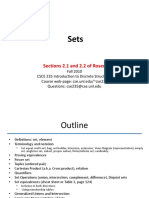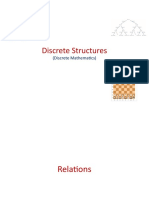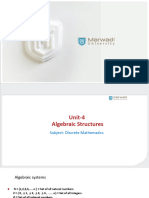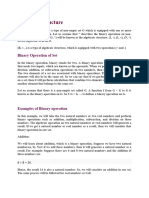Tutorial-Set Theory PDF
Uploaded by
aryan pareekTutorial-Set Theory PDF
Uploaded by
aryan pareekDISCRETE STRUCTURE FOR COMP.
SCI
(CS F222)
Tutorial : Set Theory
Ashutosh Bhatia
Department of CSIS
BITS, Pilani
August, 3, 2016
Sets
Set: is a collection of well defined objects (called the elements of the set).
Sub Set: Let A and B be any two sets. If every element of A is an element of B, then
A is called a subset of B. Symbolically this relation is denoted by A B.
For any set A, AA and A i.e., for any set A, and A are called trivial sub sets.
Some examples of set are
N = the set of natural numbers or positive integers: 1, 2, 3, . . .
Z = the set of all integers: . . . ,-2,-1, 0, 1, 2, . . .
Q = the set of rational numbers
R = the set of real numbers
C = the set of complex numbers
Observe that N Z Q R C.
Proper Sub Set: If A B and A 6= B, then A is called a proper sub set of A. This
relationship is denoted by AB.
Equal Sets: Two sets A and B are equal iff A B and B A. Sets are equal if they have
same elements.
Empty Set: A set with no elements is called the empty set and it is denoted by .
Universal Set: The set of all objects under consideration or discussion, and is denoted
by U.
Singleton: A set with only one element is called singleton.
Set Difference: A - B = {x| x | A and x
/ B}
Set Union: A B = {x| x A or x B or both}
1
Set Intersection: A B = {x| x A and x B }
Set Complement: Ac = {x| x
/ A and x U }
Disjoint Sets: Two sets A and B are said to be disjoint sets if A B =
Symmetric Difference (Boolean Sum):
A
B = (A B) (B A) = (A B) (A B)
B = {x| x A or x B but not both}
Venn Diagram: It is a pictorial representation of sets in which sets are represented
by enclosed areas in the plane. The universal set U is represented by the interior of a
rectangle, and the other sets are represented by disks lying within the rectangle.
Cardinality of a Set: The number of elements in a set is called the cardinality of that
set. It is denoted by |A|.
Power Set: Let A be any set. Then the set of all subsets of A is called the power set of
A. It is denoted by p (A)
Note: If a set A contains n elements, then its power set P(A) contains 2n elements.
The set operations satisfy the following laws:
Laws of the algebra of sets
Idempotent Laws:
AA=A
Associative Laws:
(A B) C = A
(B C)
Commutative Laws: A B = B A
Distributive Laws:
A (B C) = (A B)
(A C)
Identity Laws
A=A
AU =U
Complement Laws:
A AC = U
UC =
DeMorgans Laws:
(A B)C =AC BC
Each of the above laws has the corresponding dual.
AA=A
(A B) C = A (B C)
AB =BA
A (B C) = (A B)
(A C)
AU =A
A=
A AC =
C = U
(A B)C =AC BC
Practice Problems
1.
Is each of the following a well-defined set?
Give brief reasons for each of your answers.
(a)
(b)
(c)
(d)
(e)
2.
collection
collection
collection
collection
collection
U = R;
A = {4,
(a)
(b)
(c)
(d)
alphanumeric characters.
tall people.
real numbers x for which:
2x - 9 = 16.
integers x for which: 2x - 9 = 16.
good tennis players.
sqrt(2), 2/3, -2.5, -5, 33, sqrt(9),
set notation, write the sets of:
natural numbers in A
integers in A
rational numbers in A
irrational numbers in A
True or false?
(a)
(b)
(c)
(d)
5.
all
all
all
all
all
A
11
B
4
/
B
A
U
A = {even numbers}
Using the
4.
of
of
of
of
of
U = {natural numbers};
A = {2, 4, 6, 8, 10}; B = {1, 3, 6, 7, 8}.
State whether each of the following is true or false:
(a)
(b)
(c)
(d)
(e)
3.
The
The
The
The
The
= {0}
x {x}
=
{}
{ }
The following sets have been defined using the | notation.
Re-write them by listing some of the elements.
(a) p | p is a state capital city, p is in India
(b) x | x = 2n - 5, x and n are natural numbers
(c) y | 2y2 = 50, y is an integer
(d) z | 3z = n^2, z and n are natural numbers
6.
U = {natural numbers}; A = {2, 4, 6, 8, 10}; B = {1, 3, 6, 7, 8}
State whether each of the following is true or false:
(a) A U
(b) B A
(c) U
7.
U = {a, b, c, d, e, f, g, h}; P = {c, f}; Q = {a, c, d, e, f, h}; R = {c, d, h}
(a) Draw a Venn diagram, showing these sets with all the elements
entered into the appropriate regions. If necessary, redraw the
diagram to eliminate any empty regions.
(b) Which of sets P, Q and R are proper subsets of others?
Write your answer(s) using the symbol.
(c) P and R are disjoint sets. True or False?
You might also like
- MTHFR Protocol - Personalization by Chris Masterjohn100% (10)MTHFR Protocol - Personalization by Chris Masterjohn92 pages
- Basic Structures: Sets, Functions, Sequences and SumsNo ratings yetBasic Structures: Sets, Functions, Sequences and Sums62 pages
- John Karlo S. Mendoza BS Mechanical Engineering University of The Philippines DilimanNo ratings yetJohn Karlo S. Mendoza BS Mechanical Engineering University of The Philippines Diliman51 pages
- Sequence Cauchy Sequence Problem and SolutionNo ratings yetSequence Cauchy Sequence Problem and Solution5 pages
- 17 Recursive Definitions and Structural InductionNo ratings yet17 Recursive Definitions and Structural Induction49 pages
- MBA-502 Business Mathematics Course Instructor: Dr. A.S.A.Noor Set TheoryNo ratings yetMBA-502 Business Mathematics Course Instructor: Dr. A.S.A.Noor Set Theory20 pages
- Discrete Mathematics 4th Edition B. S. Vatsa download pdf100% (3)Discrete Mathematics 4th Edition B. S. Vatsa download pdf72 pages
- Positive Definite Matrices: Notes On Linear Algebra100% (1)Positive Definite Matrices: Notes On Linear Algebra51 pages
- Refraction of Light Refractive Index: W.R.T. Medium (1) Is Called It's Relative Refractive Index I.ENo ratings yetRefraction of Light Refractive Index: W.R.T. Medium (1) Is Called It's Relative Refractive Index I.E18 pages
- ICS141: Discrete Mathematics For Computer Science INo ratings yetICS141: Discrete Mathematics For Computer Science I22 pages
- Discrete Mathematics AND Its ApplicationsNo ratings yetDiscrete Mathematics AND Its Applications42 pages
- Discrete Mathematics - Chapter 7 Posets Lattices & Boolean AlgeNo ratings yetDiscrete Mathematics - Chapter 7 Posets Lattices & Boolean Alge82 pages
- Nested Quantifiers - Introduction: X y (X+y 0)No ratings yetNested Quantifiers - Introduction: X y (X+y 0)33 pages
- Unit - I Discrete Mathematics: Dr. Krishna Keerthi ChennamNo ratings yetUnit - I Discrete Mathematics: Dr. Krishna Keerthi Chennam105 pages
- Composite Function Classification of FunctionNo ratings yetComposite Function Classification of Function12 pages
- Test Frequency and Acceptance Criteria: Subgrade/Shoulder/Median75% (4)Test Frequency and Acceptance Criteria: Subgrade/Shoulder/Median6 pages
- Python For Reservoir Engineering and SurveillanceNo ratings yetPython For Reservoir Engineering and Surveillance7 pages
- Download Complete Designing with the Mind in Mind Simple Guide to Understanding User Interface Design Guidelines 2nd Edition Johnson PDF for All ChaptersNo ratings yetDownload Complete Designing with the Mind in Mind Simple Guide to Understanding User Interface Design Guidelines 2nd Edition Johnson PDF for All Chapters38 pages
- YARVIK XENTA 9.7 - TAB09-211 - Manual - MultilingualNo ratings yetYARVIK XENTA 9.7 - TAB09-211 - Manual - Multilingual452 pages
- Learning Objective: Understand The Application of Frictional ForceNo ratings yetLearning Objective: Understand The Application of Frictional Force19 pages
- A Robust Torque and Drag Analysis Approach For Well Planning and Drillstring Design100% (1)A Robust Torque and Drag Analysis Approach For Well Planning and Drillstring Design16 pages
- Characteristics of Different Breeds Involved in Development of Broilers & LayersNo ratings yetCharacteristics of Different Breeds Involved in Development of Broilers & Layers20 pages
- dynamic_correspondence_of_resistance_training_to.7No ratings yetdynamic_correspondence_of_resistance_training_to.79 pages
- Pole Shift Ning: Antarctic Plate LiftingNo ratings yetPole Shift Ning: Antarctic Plate Lifting7 pages
- Pediatrics PreTest Self Assessment and Review Twelfth Edition Robert Yetman - The ebook in PDF format is ready for immediate access100% (1)Pediatrics PreTest Self Assessment and Review Twelfth Edition Robert Yetman - The ebook in PDF format is ready for immediate access50 pages
- MTHFR Protocol - Personalization by Chris MasterjohnMTHFR Protocol - Personalization by Chris Masterjohn
- Basic Structures: Sets, Functions, Sequences and SumsBasic Structures: Sets, Functions, Sequences and Sums
- John Karlo S. Mendoza BS Mechanical Engineering University of The Philippines DilimanJohn Karlo S. Mendoza BS Mechanical Engineering University of The Philippines Diliman
- MBA-502 Business Mathematics Course Instructor: Dr. A.S.A.Noor Set TheoryMBA-502 Business Mathematics Course Instructor: Dr. A.S.A.Noor Set Theory
- Discrete Mathematics 4th Edition B. S. Vatsa download pdfDiscrete Mathematics 4th Edition B. S. Vatsa download pdf
- Positive Definite Matrices: Notes On Linear AlgebraPositive Definite Matrices: Notes On Linear Algebra
- Refraction of Light Refractive Index: W.R.T. Medium (1) Is Called It's Relative Refractive Index I.ERefraction of Light Refractive Index: W.R.T. Medium (1) Is Called It's Relative Refractive Index I.E
- ICS141: Discrete Mathematics For Computer Science IICS141: Discrete Mathematics For Computer Science I
- Discrete Mathematics - Chapter 7 Posets Lattices & Boolean AlgeDiscrete Mathematics - Chapter 7 Posets Lattices & Boolean Alge
- Unit - I Discrete Mathematics: Dr. Krishna Keerthi ChennamUnit - I Discrete Mathematics: Dr. Krishna Keerthi Chennam
- Test Frequency and Acceptance Criteria: Subgrade/Shoulder/MedianTest Frequency and Acceptance Criteria: Subgrade/Shoulder/Median
- Download Complete Designing with the Mind in Mind Simple Guide to Understanding User Interface Design Guidelines 2nd Edition Johnson PDF for All ChaptersDownload Complete Designing with the Mind in Mind Simple Guide to Understanding User Interface Design Guidelines 2nd Edition Johnson PDF for All Chapters
- YARVIK XENTA 9.7 - TAB09-211 - Manual - MultilingualYARVIK XENTA 9.7 - TAB09-211 - Manual - Multilingual
- Learning Objective: Understand The Application of Frictional ForceLearning Objective: Understand The Application of Frictional Force
- A Robust Torque and Drag Analysis Approach For Well Planning and Drillstring DesignA Robust Torque and Drag Analysis Approach For Well Planning and Drillstring Design
- Characteristics of Different Breeds Involved in Development of Broilers & LayersCharacteristics of Different Breeds Involved in Development of Broilers & Layers
- dynamic_correspondence_of_resistance_training_to.7dynamic_correspondence_of_resistance_training_to.7
- Pediatrics PreTest Self Assessment and Review Twelfth Edition Robert Yetman - The ebook in PDF format is ready for immediate accessPediatrics PreTest Self Assessment and Review Twelfth Edition Robert Yetman - The ebook in PDF format is ready for immediate access

























































































